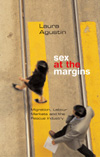 I’m speaking at Salon for the City on Thursday night this week. The title of the salon is London: City of Sex Work, and my co-speaker is Julie Peakman. I’ll be focusing on the 14th century in Southwark, but it’s not all about the Bankside brothels. In fact my annoyance about how guides usually talk about the Bankside was a reason I got into the guiding business. The picture shows me there along the river.
I’m speaking at Salon for the City on Thursday night this week. The title of the salon is London: City of Sex Work, and my co-speaker is Julie Peakman. I’ll be focusing on the 14th century in Southwark, but it’s not all about the Bankside brothels. In fact my annoyance about how guides usually talk about the Bankside was a reason I got into the guiding business. The picture shows me there along the river.
In a previous career as activist-public speaker about migration, prostitution law and sex workers’ rights I focused on the present day on an international level, because women who migrate from all parts of the world to all other parts of the world often sell sex at some point. They may have planned to or they may have been duped into it. They may hate or only tolerate selling sex – or they may find it works for them better than the other (less than desirable) jobs open to them as undocumented wanderers or purposeful migrants.
 When I was doing a PhD I did long research into how societies have thought about prostitution, to understand the contemporary resistance to accepting sex work as a job. My book Sex at the Margins: Migration, Labour Rights and the Rescue Industry includes a historical chapter which as a primer I still recommend. In our own time the conflict about this topic feels endless and unproductive, a fight about what feminism is supposed to be. I was glad to leave that behind.
When I was doing a PhD I did long research into how societies have thought about prostitution, to understand the contemporary resistance to accepting sex work as a job. My book Sex at the Margins: Migration, Labour Rights and the Rescue Industry includes a historical chapter which as a primer I still recommend. In our own time the conflict about this topic feels endless and unproductive, a fight about what feminism is supposed to be. I was glad to leave that behind.
But when I decided to guide, a central motivation was to include people nearly always omitted from historical walks – not to say from historical accounts in general, where poorer working people form an inanimate background to Great Events. Including ordinary working people means including those who sell sex in many different settings and forms, in whatever era and place the walk is about.
 For my walk Scratching Out a Living: the Medieval Female Proletariat I created six women working near the Thames in 14th-century Southwark. Their characters are based on long research, including in the world of illuminated manuscripts. I’ve written about this research, which led to creating a walk that first appeared as part of the Totally Thames Festival in September last year.
For my walk Scratching Out a Living: the Medieval Female Proletariat I created six women working near the Thames in 14th-century Southwark. Their characters are based on long research, including in the world of illuminated manuscripts. I’ve written about this research, which led to creating a walk that first appeared as part of the Totally Thames Festival in September last year.
I’ll be talking about this at the Salon: how poorer women got by in a legal and social context that was all against them. Inevitably every one of them has some relation to the sex industry — and I use that term advisedly because everything isn’t now and wasn’t then ‘prostitution’. The brief talk aims to show how commercial sex was everywhere in the fabric of everyday life, as I believe it is now. The above picture is from marginalia in the Luttrell Psalter, catalogued as Add. 42130, f.63 at the British Library. Commentators usually say the woman on the left is a prostitute because she is vainly combing her hair and looking in a mirror (. . .)
 I’m doing the walk again on 2 May as an after-work event with fellow-guide Rob Smith, who provides the Big-History context for the lives of the female proletariat. It’s a wonderful walk through areas you may think you already know (here for instance by Southwark Cathedral and Borough Market), and it ends in a riverside pub for refreshment and further conversation, which has become an integral part of my walks. I want to hear what everyone has to say. You can book here.
I’m doing the walk again on 2 May as an after-work event with fellow-guide Rob Smith, who provides the Big-History context for the lives of the female proletariat. It’s a wonderful walk through areas you may think you already know (here for instance by Southwark Cathedral and Borough Market), and it ends in a riverside pub for refreshment and further conversation, which has become an integral part of my walks. I want to hear what everyone has to say. You can book here.
Follow me on Eventbrite to hear when new walks and new dates are published. And I’ve now got 20 reviews on TripAdvisor, if you want to hear how walkers have seen my walks.
emma
—Laura Agustín, the Naked Anthropologist
